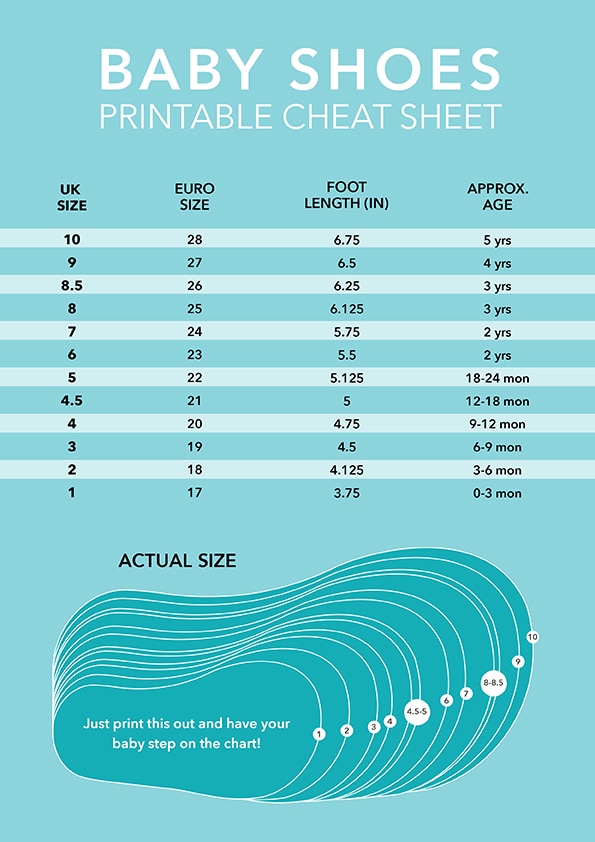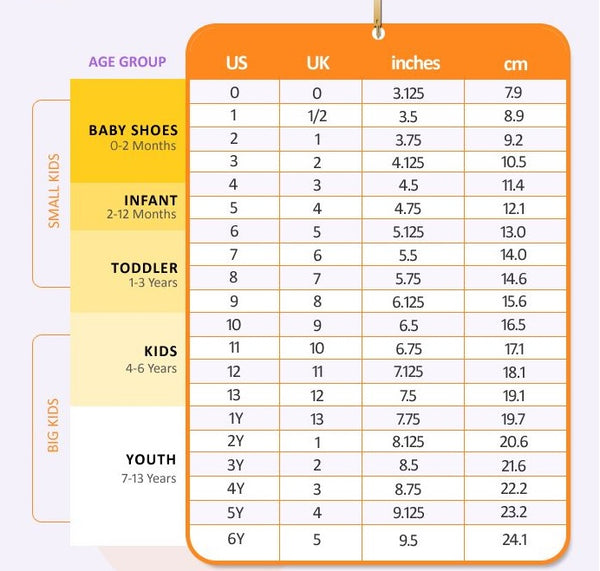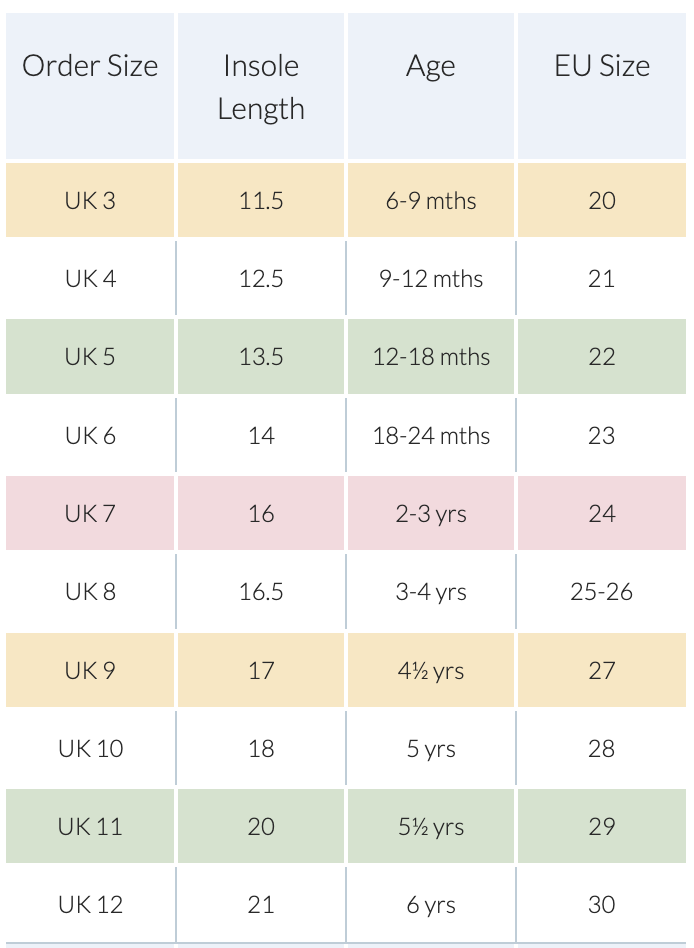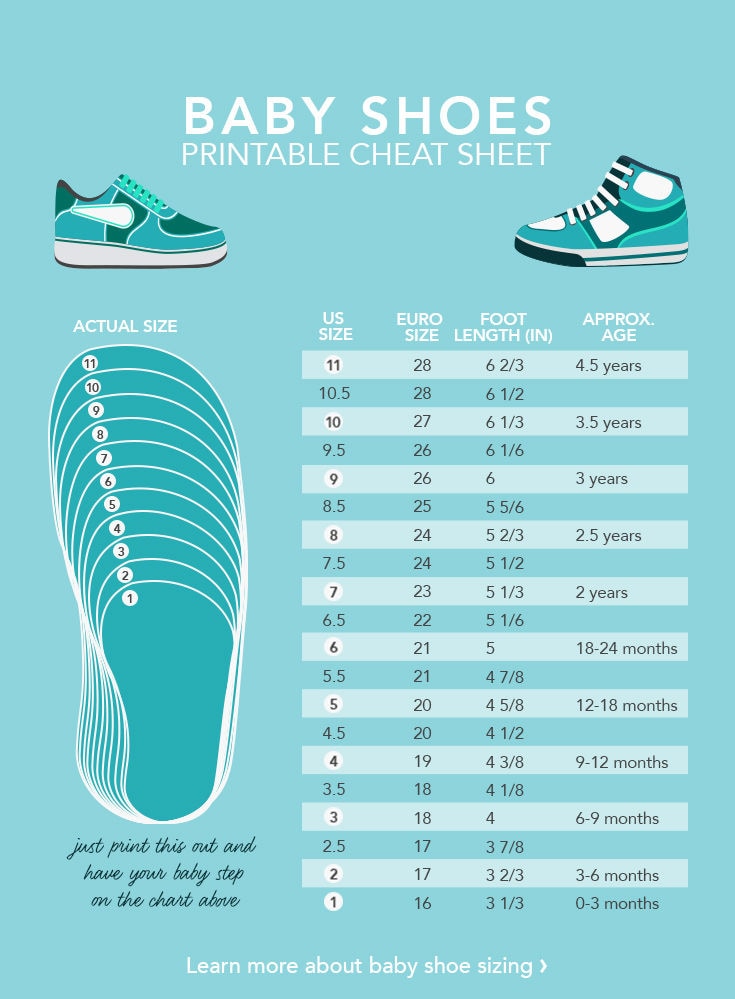Understanding Infant Shoe Sizes
When it comes to buying shoes for your precious little ones, understanding infant shoe sizes can be a bit confusing. Most parents want to ensure their baby’s comfort and support during their early walking stages. Generally, infant shoe sizes range from newborn (size 0) up to toddler sizes (size 5). Each size corresponds to the length and sometimes the width of your baby’s foot.
It is crucial to choose the correct size to promote healthy foot development. According to the American Association of Pediatrics, shoes that fit well can help prevent foot deformities and discomfort in children. As a parent or guardian, it demands a careful balance of style and functionality.
Infant Shoe Size Chart
Size Chart Overview
| Age | US Size | Foot Length (inches) | Foot Length (cm) |
|---|---|---|---|
| 0-3 Months | 0 | 3.5″ | 8.9 cm |
| 3-6 Months | 1 | 4.0″ | 10.2 cm |
| 6-12 Months | 2 | 4.5″ | 11.4 cm |
| 12-18 Months | 3 | 5.0″ | 12.7 cm |
| 18-24 Months | 4 | 5.5″ | 14.0 cm |
| 2-3 Years | 5 | 6.0″ | 15.2 cm |
This size chart provides a general guideline. However, always measure your child’s feet before making a purchase, as different brands may have slight variations in sizing.
How to Measure Your Infant’s Foot Size
Tools Needed
- Ruler or measuring tape
- A piece of paper
- Pencil
- A flat surface
Step-by-Step Guide
Measuring your baby’s feet at home is straightforward. Here’s how to do it:
- Have your baby stand barefoot on a flat surface with their feet flat and parallel.
- Place a piece of paper on the floor against the wall, ensuring it is taped down to prevent it from moving.
- Trace around the foot with a pencil, keeping the pencil upright to ensure an accurate outline.
- Measure the distance from the back of the heel to the longest toe using a ruler or tape measure.
- Repeat for the other foot, as some children may have different-sized feet.
Record the measurements in both inches and centimeters for reference against the size chart.
Selecting the Right Infant Shoes
Key Features to Consider
When selecting the perfect pair of shoes for your growing infant, consider these key features:
- Material: Soft, breathable materials like canvas or leather are ideal. Avoid rigid materials that can cause discomfort.
- Flexibility: Shoes should have a flexible sole that allows natural foot movement.
- Fit: Ensure there’s a thumb’s width of space between the end of the shoe and your baby’s longest toe. A snug fit is essential but not too tight.
- Closure Type: Velcro straps can make it easier to put on and take off shoes, while laces offer a more secure fit as they grow.
- Weight: Lightweight shoes are preferable to ensure your baby can move freely.
Real-World Footwear Experiences
What Parents Are Saying
Many parents emphasize the importance of comfort and fit. For instance, Sarah, a mother from California, mentions how she struggled with finding shoes for her son who is particularly active. She found that brands like Stride Rite offered a variety of sizes and widths, enabling her to find the perfect fit. Sarah reported that her son was more willing to walk and explore once he had the right shoes, showcasing the importance of appropriate footwear.
Another parent, John from New York, shared his experience with a brand that promised “one size fits all.” He soon realized that this wasn’t the case when his daughter developed blisters. After switching to a more dedicated brand with a proper fitting guide, he noticed that the issues disappeared. This shows the necessity of choosing brands that understand the infant foot and offer a comprehensive sizing chart.

Case Study: The Impact of Proper Shoe Sizing
Analysis of Pediatric Studies
A recent study published in the Journal of Pediatric Orthopedics found that incorrectly sized shoes could increase the risk of foot deformities in young children. The study observed that children wearing shoes that were too tight showed a significantly higher incidence of hallux valgus, commonly known as bunions. Similarly, children with shoes that were too loose experienced more frequent trips and falls.
The researchers emphasized that proper shoe fitting is critical during the early stages of walking, as the bones and ligaments are still developing. The American Academy of Pediatrics also reinforces this, stating that shoes should fit well and allow for natural foot movement. You can read more about their findings in the full study here.
Infant Shoe Comparison Table
| Brand | Size Range | Material | Closure Type | Price |
|---|---|---|---|---|
| Stride Rite | 0-5 | Leather, Mesh | Velcro, Laces | $40-$60 |
| See Kai Run | 0-5 | Leather | Velcro | $50-$70 |
| Nike | 0-5 | Synthetic | Laces | $60-$90 |
| Adidas | 0-5 | Synthetic | Velcro, Laces | $65-$85 |
Each brand has its unique features. Stride Rite is known for its durability and wide range of sizes, while See Kai Run emphasizes style and comfort.

Pros and Cons of Infant Shoes
Benefits of Proper Footwear
Pros
- Promotes healthy foot development
- Provides traction and stability
- Offers protection from outdoor elements
- Supports natural movement and growth
Potential Drawbacks
- Can be expensive if you need to frequently replace them
- Some designs may not be adequately supportive
Tips for Maintaining Infant Shoes
How to Care for Your Baby’s Footwear
To extend the life of your infant’s shoes, follow these care tips:
- Regular Cleaning: Wipe down the shoes with a damp cloth after each use. For tougher stains, use mild soap.
- Air Dry: Avoid using a dryer; let the shoes air dry away from direct sunlight to prevent damage.
- Inspect for Wear: Regularly check the soles and material for signs of wear and tear. If the shoes are losing traction or becoming worn down, it may be time to replace them.

FAQs about Infant Baby Shoes Size Chart
1. How often should I measure my baby’s feet?
It’s recommended to measure your baby’s feet every few months, as they grow quickly during their first few years.
2. What size should I buy if my child is between two sizes?
If your child is between sizes, it’s usually best to go for the larger size to ensure comfort and room for growth.

3. Are sandals suitable for infants?
Sandals can be suitable for infants, but ensure they provide enough support and have straps that secure the foot properly.
4. What are the signs that my baby’s shoes are too tight?
Look for signs like redness, marks on the skin, or your baby frequently pulling at their shoes. A well-fitting shoe should not cause any discomfort.

5. Can I buy second-hand infant shoes?
While second-hand shoes can save money, avoid buying them if they show significant wear, as they might not provide the necessary support.
6. How do I know if a shoe is good for my infant?
Look for a flexible sole, supportive heel, and breathable material. The shoe should also fit securely without being tight.

7. How can I encourage my baby to wear shoes?
Make it a fun activity! Allow your baby to help choose the shoes, and put them on during playtime to create positive associations.
8. Do all brands fit the same?
No, shoe sizing can vary significantly between brands. Refer to their specific sizing charts and reviews for accurate fitting.

9. Should I buy waterproof shoes for my infant?
Waterproof shoes can be beneficial for wet weather, but ensure they are also breathable to avoid moisture buildup inside.
10. When should my child start wearing a specific shoe type?
Infants should wear soft-soled shoes until they are walking confidently, after which supportive shoes can be introduced.
11. What should I avoid when selecting infant shoes?
Avoid shoes that are made from stiff materials, lack a proper fit, or have high heels or rigid soles.
Conclusion
Choosing the right infant shoes is crucial for your child’s foot development and comfort. By understanding the size chart, measuring accurately, and selecting the right features, you can make informed decisions that positively impact your baby’s growth. Remember to prioritize comfort, support, and fit over style. With the right knowledge and tools, you can confidently navigate the world of infant footwear!